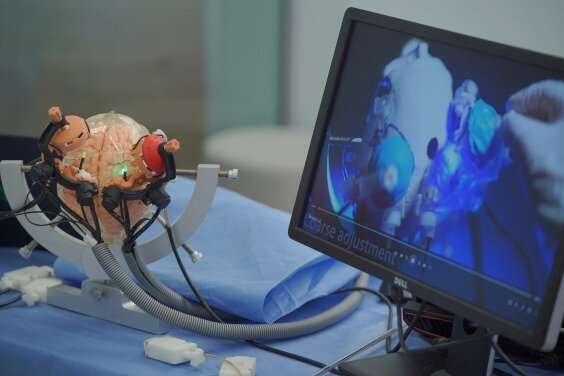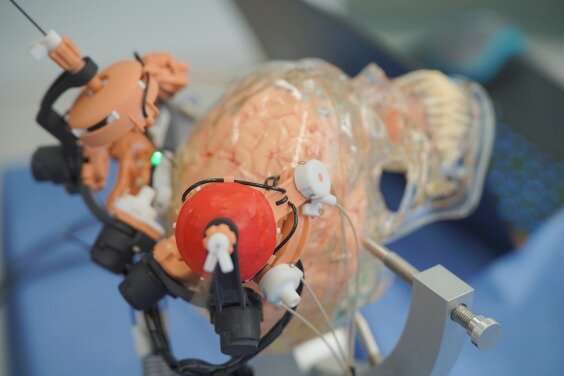This article has been reviewed according to Science X's editorial process and policies. Editors have highlighted the following attributes while ensuring the content's credibility:
fact-checked
peer-reviewed publication
trusted source
proofread
Research team develops MRI-guided multi-stage robotic positioner for precise stereotactic neurosurgery

A research team led by Professor Ka-Wai Kwok from the Department of Mechanical Engineering at the University of Hong Kong (HKU) has developed an interactive multi-stage robotic positioner specifically designed for magnetic resonance imaging (MRI)-guided stereotactic neurosurgery.
This technology represents a key breakthrough in MRI-guided stereotactic neurosurgery, allowing for precise interventions. The system is capable of assisting with interventions involving cannula/needle targeting including deep brain stimulation (DBS), for the treatment of movement disorders like Parkinson's disease. It also facilitates a wide range of therapeutic applications such as biopsy, drug delivery, ablation, and catheter placement within deep brain regions.
In 2018, Professor Kwok's team successfully created the world's first robotic system capable of performing bilateral stereotactic neurosurgery in an MRI environment, addressing the challenges of long procedural times and complicated workflow.
Collaborating with clinical experts Professor Wai-Sang Poon from the Department of Surgery at HKU, and Dr. Danny Tat Ming Chan from the Division of Neurosurgery, Department of Surgery at CUHK, the team has further refined the initial prototype. The system developed has been validated through cadaveric studies and skull model testing, achieving a precision error of less than 3 mm and demonstrating immense potential for integration into clinical practice. A patent has been applied for the invention.
The HKU Engineering team includes: Hon-Sing Tong, Ge Fang, Chim-Lee Cheung, Ph.D. student: Jing Dai, as well as research fellows: Zhuoliang He, Xiaomei Wang and Justin D.L. Ho.
The updated prototype has been reported in the journal Advanced Science. The latest development of the system enables interactive, semi-automatic manipulation in two stages:
Stage 1. Manual coarse adjustment performed interactively by surgeon
Based on pre-operative images, the surgeon orients the robot instrument guide towards the direction of the planned trajectory. Fiber-optic lighting built into the system intuitively indicates the angulation error with reference to the planned trajectory. Once the instrument guide is close to the planned trajectory with an error less than 5°, the system will be remotely locked.

Stage 2. Automatic fine adjustment with precise, responsive, and high-resolution soft robotic positioning
Making use of finite element analysis (FEA)- based design and optimization of the fluid-driven soft actuator architecture, the instrument could be positioned accurately with
The surgeon then manually inserts the instrument via the robot instrument guide. The insertion depth is set with the assistance of a stopper. The system can eliminate the intrinsic errors in conventional frame-based stereotaxis. As a result, insertion precision will increase, securing surgical outcomes. The shorter operation time will help to improve patient comfort and satisfaction.
The compact and lightweight skull-mounted robot (97 x 81 mm, 203g) is designed to fit most standard imaging head coils. It features custom-made miniature wireless omni-directional tracking markers and a zero-electromagnetic-interference system to facilitate robot registration under real-time MRI.
More information: Zhuoliang He et al, Interactive Multi‐Stage Robotic Positioner for Intra‐Operative MRI‐Guided Stereotactic Neurosurgery, Advanced Science (2023). DOI: 10.1002/advs.202305495





















